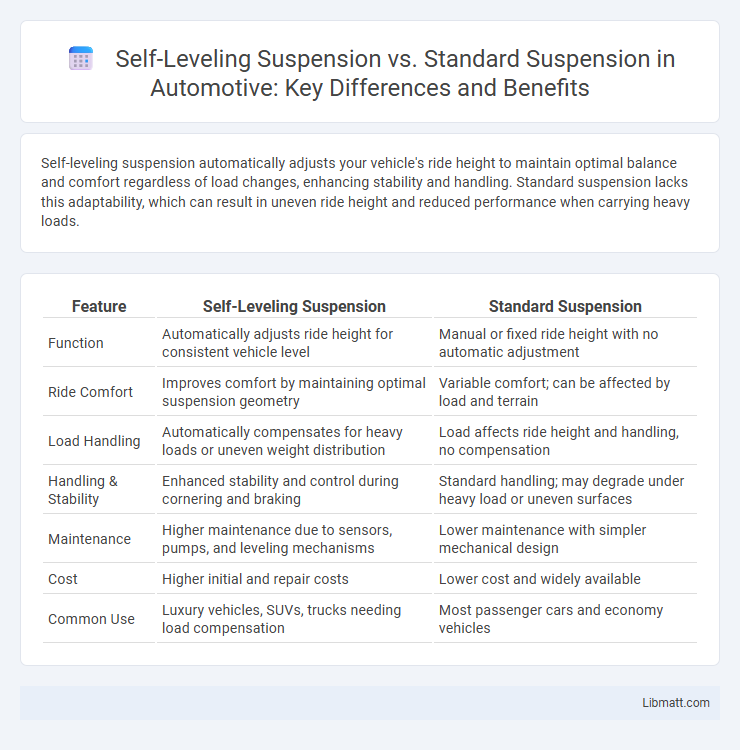Self-leveling suspension automatically adjusts your vehicle's ride height to maintain optimal balance and comfort regardless of load changes, enhancing stability and handling. Standard suspension lacks this adaptability, which can result in uneven ride height and reduced performance when carrying heavy loads.
Table of Comparison
| Feature | Self-Leveling Suspension | Standard Suspension |
|---|---|---|
| Function | Automatically adjusts ride height for consistent vehicle level | Manual or fixed ride height with no automatic adjustment |
| Ride Comfort | Improves comfort by maintaining optimal suspension geometry | Variable comfort; can be affected by load and terrain |
| Load Handling | Automatically compensates for heavy loads or uneven weight distribution | Load affects ride height and handling, no compensation |
| Handling & Stability | Enhanced stability and control during cornering and braking | Standard handling; may degrade under heavy load or uneven surfaces |
| Maintenance | Higher maintenance due to sensors, pumps, and leveling mechanisms | Lower maintenance with simpler mechanical design |
| Cost | Higher initial and repair costs | Lower cost and widely available |
| Common Use | Luxury vehicles, SUVs, trucks needing load compensation | Most passenger cars and economy vehicles |
Introduction to Suspension Systems
Self-leveling suspension automatically adjusts the vehicle's height to maintain optimal ride quality and stability regardless of load changes. Standard suspension systems rely on fixed components that do not adapt, potentially causing uneven tire wear and compromised handling under varying weights. Innovations in self-leveling technology enhance comfort, safety, and performance, especially in trucks and SUVs carrying heavy or uneven loads.
What is Self-Leveling Suspension?
Self-leveling suspension automatically adjusts the vehicle's ride height to maintain a consistent, level stance regardless of load, improving handling and comfort. Designed to counteract sagging caused by heavy cargo or passengers, it uses sensors and hydraulic or air systems to balance weight distribution. Your driving experience benefits from enhanced stability and reduced wear on suspension components compared to standard suspension systems.
Understanding Standard Suspension
Standard suspension systems typically use fixed-rate springs and traditional shock absorbers to provide a consistent ride height and handling characteristics regardless of load. These systems prioritize simplicity and cost-effectiveness but can result in variable ride comfort and stability when the vehicle is heavily loaded or unevenly weighted. Understanding standard suspension highlights its limitations in maintaining optimal vehicle balance compared to self-leveling suspension technology.
Key Differences Between Self-Leveling and Standard Suspension
Self-leveling suspension automatically adjusts the vehicle's height to maintain a constant ride level regardless of load, enhancing stability and comfort. Standard suspension relies on fixed springs and shocks, which may cause sagging or uneven ride height under heavy loads, impacting handling and tire wear. The self-leveling system uses sensors and compressors, while standard systems lack these adaptive components, resulting in less consistent performance across varying weights.
Advantages of Self-Leveling Suspension
Self-leveling suspension maintains a constant ride height regardless of load, improving vehicle stability and handling in varying conditions. Your driving experience benefits from enhanced comfort and safety due to reduced body roll and better traction on uneven terrain. This advanced suspension system also minimizes wear on tires and suspension components, increasing overall vehicle longevity.
Advantages of Standard Suspension
Standard suspension offers simplicity and cost-effectiveness, making it easier to maintain and repair compared to self-leveling systems. Its fewer components reduce the risk of mechanical failures and contribute to longer overall durability. Standard suspension provides consistent performance under typical driving conditions, ensuring reliability without the complexity of advanced adjustments.
Performance Comparison: Comfort and Handling
Self-leveling suspension maintains optimal ride height regardless of load, enhancing your vehicle's stability and handling on uneven terrain, while standard suspension may cause uneven stance and reduced control under heavy loads. Comfort-wise, self-leveling suspension provides a smoother ride by preventing sagging and absorbing shocks more effectively compared to standard setups that can become stiff or bouncy. You'll experience improved traction and safety with self-leveling systems, especially in challenging driving conditions where consistent suspension performance is crucial.
Maintenance and Cost Considerations
Self-leveling suspension systems typically require more maintenance due to their complex hydraulic or electronic components, resulting in higher servicing costs compared to standard suspension. Standard suspension systems have simpler designs, leading to lower maintenance expenses and easier repairs over time. Choosing self-leveling suspension may increase your initial investment and ongoing costs but offers better ride comfort and load management.
Applications: Which Vehicles Use Each System?
Self-leveling suspension systems are primarily used in luxury vehicles, SUVs, and trucks that require consistent ride height under varying load conditions, such as the Mercedes-Benz S-Class, Audi Q7, and heavy-duty pickup trucks. Standard suspension systems are commonly found in most passenger cars and light-duty vehicles, offering a balance of comfort and cost-effectiveness without automatic height adjustment. Vehicles intended for off-road use or heavy cargo transport often favor self-leveling suspension to maintain optimal stability and handling.
Choosing the Right Suspension for Your Needs
Self-leveling suspension automatically adjusts to maintain optimal vehicle height and stability under varying loads, enhancing ride comfort and safety. Standard suspension offers a fixed setup that may compromise handling when carrying heavy or uneven cargo. Your choice depends on whether you prioritize adaptability and consistent performance (self-leveling) or prefer a simpler, cost-effective system (standard suspension).
Self-leveling suspension vs Standard suspension Infographic

 libmatt.com
libmatt.com